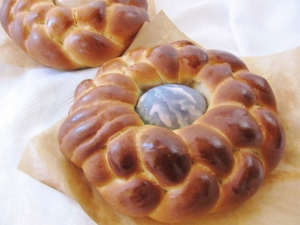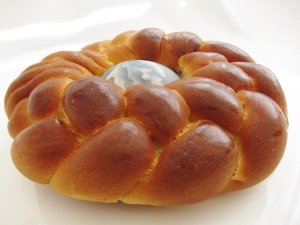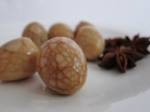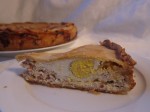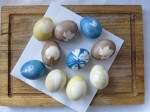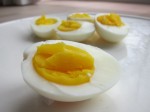
When you spend a few days in a holiday home you only buy what is absolutely essentials for your stay, right?!
This is how – during our recent trip to France – I discovered that buckwheat and spelt flour are totally indispensable! At least, this is what I deduct from the fact that they landed in the cart on our first shopping trip.
Or do I need to accept that I might be dealing with a touch of bread-baking obsession here? (Especially as my previous post is also about a holiday-bread experience)
No! Thankfully I can reverse-construct a good “reason”: there was no bakery close to our little holiday house, which meant that having these flours saved us from the horrible fate of suffering stale bread.
Actually I need to correct myself on one point here: I can hardly describe the place as “little”. It was a huge converted barn – a “little” dark and cold, but incredibly spacious with a fabulously equipped kitchen….and a huge oven that just had to be used.

(Let’s hope nobody will notice I am side-stepped the flour-situation by inserting holiday pictures of our “little shed” and lovely Saint-Cirq-Lapopie).
But now about these scones:
- Quick and no fuss – they come together in no time at all. A little stir, roll, cut, and bake. No resting required.
2. A note on the cheese – it makes the scones better but is not absolutely necessary: without the cheese they are still tasty, however the texture of both crumb and crust is a little more solid. They are certainly less golden and pretty. If you are watching your fat-intake you can leave out the cheese, but otherwise I would suggest using it.
3. And then the secret trick – first you press the dough with your hands to half the thickness you would for a scone. After that you fold the dough double, press it lightly again before you cut out the scones. This creates a beautifully layered scone that breaks open easily. I am sure I will use this trick for other recipes as well.
4. Substantial – these innocent looking biscuits will fill you up and keep your hunger at bay for a good while. For a full breakfast or lunch they are fabulous with scrambled eggs (with spinach and tomato, or filled with cottage cheese and chives, for example).
Ingredients
(from the blog ‘The Healthy Epicurean‘)
Serves 4 (12/16 or so scones)
150g spelt flour
100g buckwheat flour
3 tsp baking powder
1/2 tsp paprika
large pinch sea salt
1 tbsp chia seeds (optional)
100g strong cheese* (as I was in France I used aged Comté as suggested in the original recipe)
1 tbsp olive oil
125 ml milk
1 egg
Recipe
- Preheat oven to 180C.
- In a large bowl sift together the two types of flour, baking powder, paprika and salt. Add chia if using.
- Grate the cheese. Using a metal spoon stir the cheese into the dry ingredients.
- In a separate bowl mix together the egg and milk. Then add the olive oil.
- Pour the wet ingredients into the dry ingredients. Using the metal spoon quickly stir together until a dough starts to form (add a little milk if the dough is too dry).
- Using your hands press the dough on a clean surface to about 5mm thick. (Do not use a rolling pin. It is too heavy and will stop the scones from rising.)
- Fold the dough back onto itself and gently flatten with the palm of your hand. (Folding it double will create that “break” in de the middle to cut the scone open.)
- Using a round cutter to cut scones (about 12-16 depending on the size of your cutter). You can gather the scraps and flatten them out again, be careful not to overwork the dough.
- Place on a baking tray and bake about 15 minutes until golden.
- Serve hot or cold.
Tips & Variations
* You can omit the cheese; however the crumb as well as crust have a better texture with the cheese. On top of that the cheese makes the scones look wonderfully golden. But if you are watching your fat intake you can leave out the cheese and have a fabulously healthy scone.
Serve with
- Scrambled eggs (with spinach and tomato, or filled with cottage cheese and chives, for example)
- Brie and grapes
Other bread recipes

























